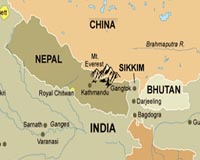| . |  |
. |
Paris (AFP) Sept 27, 2009 People who were killed, injured or bereaved in the 2008 Sichuan earthquake had the cruel misfortune to be victims of an event that probably occurs just once in four millennia, seismologists said on Sunday. In a paper published in the journal Nature Geoscience, Shen Zhengkang of the China Earthquake Administration and colleagues said the May 12, 2008 quake comprised a strong seismic wave, unusual geology and the failure of three subterranean "barriers" to resist the shock. Using Global Positioning System (GPS) markers and data from satellite-borne interferometric radar, the scientists built up a picture of the Longmen Shan fault, on the northwest rim of the Sichuan basin, as it was gouged open by the 7.9-magnitude temblor. Nearly 88,000 people were killed in what was the largest seismic event in China in more than 50 years. The investigators said the sub-surface geometry is complex, varying significantly along the length of the fault zone. In the southwest of the zone, the fault's plane dips slightly to the northwest. It then rides up, becoming nearly vertical, in the zone's northeast. Added to this is a change in motion -- principal movement -- along the fault. The motion initially starts out as a thrust, a vertical movement in which lower layers of rock are pushed up and on top of higher layers. Farther along the fault, this changes to so-called strike-slip movements, which are lateral. Three junction segments which have held up for years received extraordinary blows that day when the main shock was unleashed about 30 kilometers (18 miles) southwest of the city of Yingxiu, the paper says. A wave of energy rocketed along the fault, ripping open the rock beneath Yingxiu as well as Beichuan and Nanba, which is where the biggest earth slippages -- and fatalities -- occurred. These three locations were "barriers" that were smashed down in a single, exceptional event and caused the rest of the fault to rip open, the study said. "We estimate that the failure of barriers and rupture along multiple segments takes place approximately once in 4,000 years," it said. Offering a morsel of comfort, Shen told AFP: "There are still aftershocks, but I don't think there is big chance in that region of another big one" for the foreseeable future. Share This Article With Planet Earth
Related Links Bringing Order To A World Of Disasters When the Earth Quakes A world of storm and tempest
 Quake kills ten in Bhutan:report
Quake kills ten in Bhutan:reportGuwahati, India (AFP) Sept 21, 2009 A strong 6.1-magnitude earthquake struck the remote Himalayan kingdom of Bhutan Monday, killing at least ten people and damaging monasteries and other buildings, state-run media reported. "Ten people were killed of which three victims are of Indian origin," Bhutan Broadcasting Service, the country's national radio reported Monday night. The three Indians died after they were hit by ... read more |
|
| The content herein, unless otherwise known to be public domain, are Copyright 1995-2009 - SpaceDaily. AFP and UPI Wire Stories are copyright Agence France-Presse and United Press International. ESA Portal Reports are copyright European Space Agency. All NASA sourced material is public domain. Additional copyrights may apply in whole or part to other bona fide parties. Advertising does not imply endorsement,agreement or approval of any opinions, statements or information provided by SpaceDaily on any Web page published or hosted by SpaceDaily. Privacy Statement |